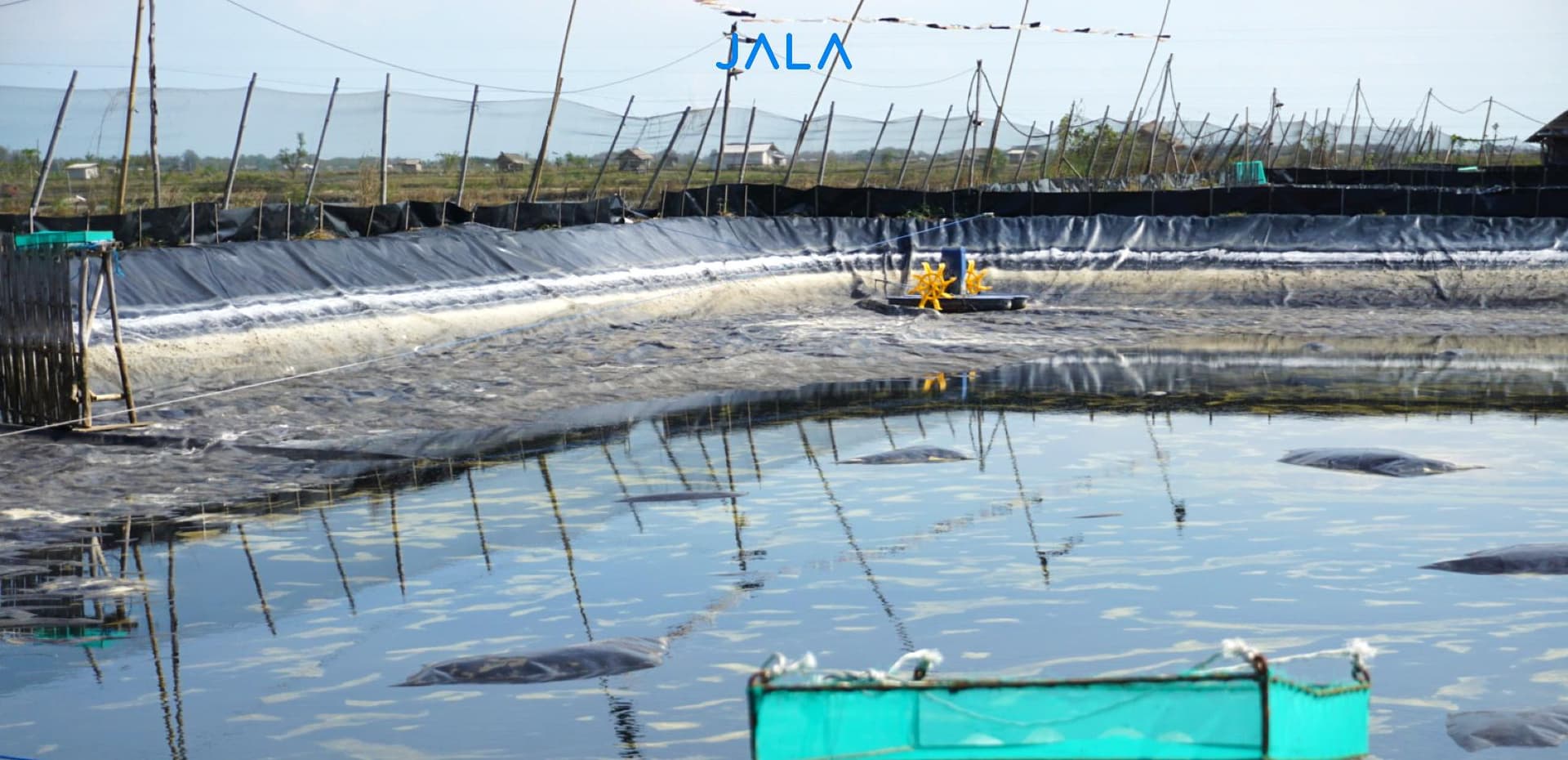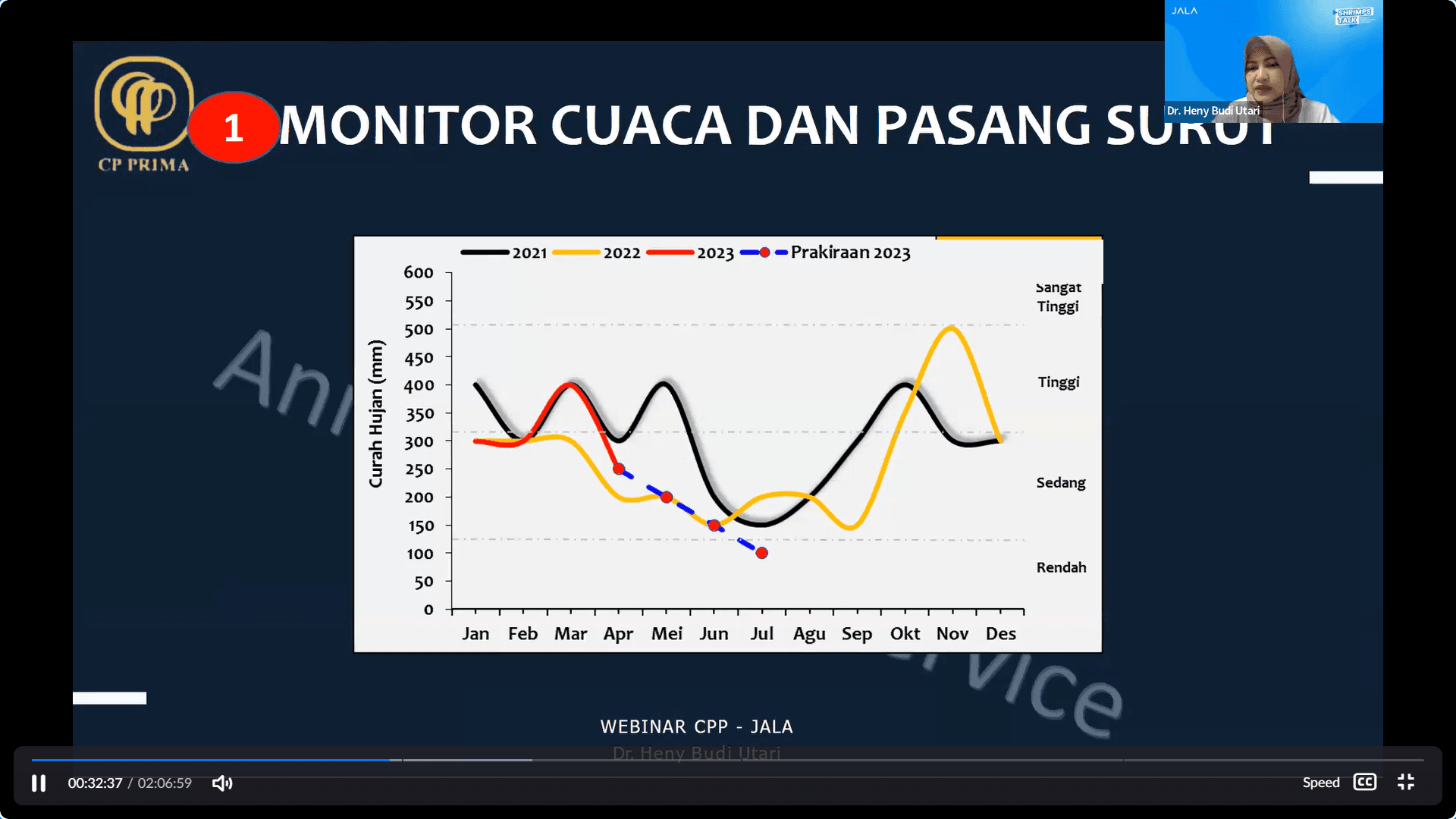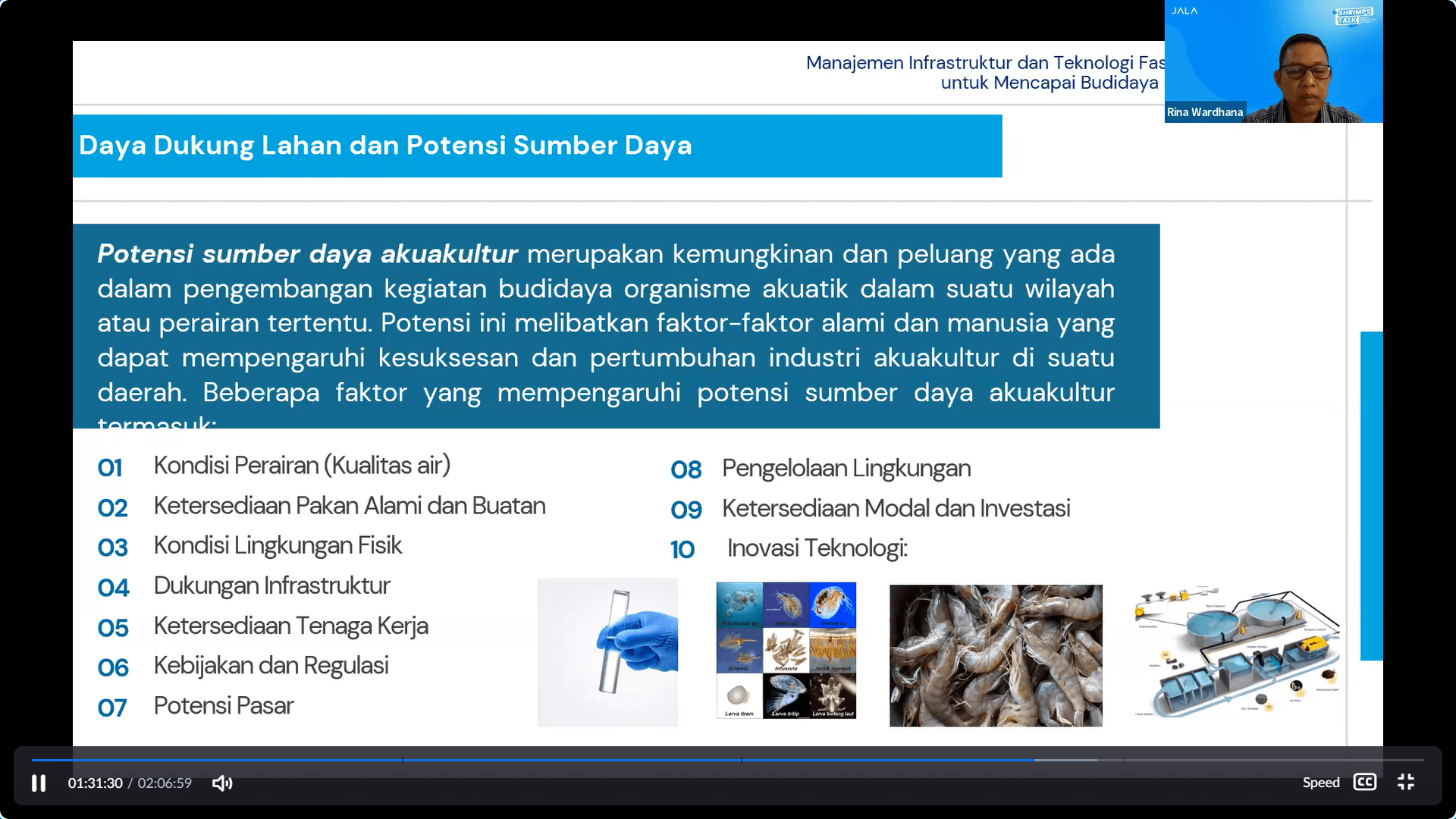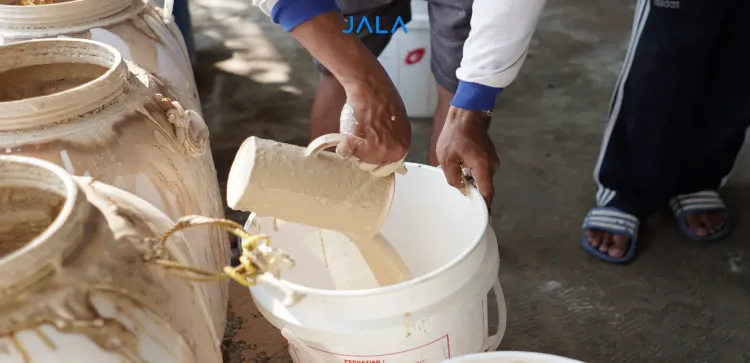
Disease is still a major challenge in shrimp farming. Apart from the risk of leading to cultivation failure, disease is also the beginning of losses. Meanwhile, many farmers are still unaware of the importance of technology for shrimp cultivation, whereas technology plays a significant role in reducing issues in cultivation.
To help farmers in dealing with disease and grasp the importance of shrimp farming technology, JALA held the 12th SHRIMPS TALK webinar on November 28, 2023. There were 98 attendees in this webinar, all of them were eager to learn and discuss these two topics.
This SHRIMPS TALK featured two speakers, namely Dr. Heny Budi Utari, M.Sc. (General Manager of Animal Health Service of CP. Prima) and Rina Wardhana, S.T. (Senior Technical Manager of JALA). In particular, Dr. Heny talked about strategies for controlling shrimp diseases, while Mr. Rina discussed the technological management of shrimp ponds.
5 strategies to control shrimp diseases
Some shrimp farmers use certain organic materials to increase plankton growth. However, the addition of organic material goes along with a high stocking density, resulting in collapse.
Regarding the administration of organic materials into the cultivation system, Dr. Heny advised farmers to ensure that the organic materials administered can be broken down properly to avoid disease. Using low-protein feed is an alternative way to keep the amount of organic waste under check.
In addition, there are still many farmers who have not installed wastewater treatment plants. Meanwhile, pond waste contains feed residue, feces, bacteria, viruses, fungi, and more. This untreated pond waste will ultimately trigger the emergence of shrimp diseases.

Regarding shrimp disease control, Dr. Heny suggested the implementation of these 5 strategies:
1. Monitor weather and tides
According to the attached data, rainfall increases significantly near the end of 2022 but drops in December of the same year. Shrimp farmers should monitor the weather because of this fluctuating behavior. That way, they can predict when the tides will occur and when the rainfall will increase.
2. Genetic improvement
The shrimp industry in Ecuador has succeeded in developing SPR (Specific Pathogen Resistant) broodstock. Even though EHP are still found, they can survive because the stocking density in the pond is not too high. Meanwhile, the shrimp industry in Vietnam starts using nursery ponds to better prepare their fry for life in grow-out ponds.
3. Biosecurity implementation
Biosecurity must be implemented at every stage of cultivation. During preparation, farmers can install bird scaring devices and crab protecting walls. Meanwhile, once the cultivation process is underway, farmers can provide simple hand washing facilities in the pond and monitor shrimp health regularly.
4. Transformation of cultivation systems
It is also possible to transform cultivation systems, particularly in the case of plankton systems, plankton-bacteria balance, and indoor and outdoor biofloc systems. The biofloc system is believed to be capable of controlling pathogens and handling AHPND and EHP.
In addition, the usage of filters made of different materials, such as stone, palm fiber, and so forth, can be taken into consideration. Water filters can reduce TOM values by <10 ppm, but it must still be accompanied by water changes. Other essential facilities are pumps, central and upper drainage, and reservoirs.
Another factor that is no less important is adequate pond water. Since many ponds have difficulty implementing water changes, the buildup of organic matter and vibrio content in them is quite high.
5. Controls vibrio
It is critical to monitor the results of bacteria and water quality analyses in order to control vibrio in ponds. Through feeding trays, farmers can identify shrimp samples to control the shrimp's diet and overall health. In addition, administering probiotics helps strengthen the immune system of the shrimp.
In conclusion, diseases remain a problem for shrimp farming, particularly those caused by vibrio. In the meantime, further research is needed to determine the optimal disease control measures, which must also be properly applied for shrimp farming to be successful.
Technology management in shrimp farms
Dr. John A. Hargreaves, an aquaculture expert with over 40 years of experience, defines aquaculture as an effort to produce aquatic organisms with economic or social value from a source by using controlled technological methods. Thus, the role of technology needs to become farmers’ attention.
Given the high potential of aquaculture resources, there are several important factors that influence the success and growth of the aquaculture industry. Apart from water quality, feed availability, physical environmental conditions, and so on, technological innovation also has a significant role.

Aquaculture technology refers to the collection of methods, knowledge, and tools used in the practice of cultivating shrimp, fish, and aquatic plants. It covers various aspects, including technology levels, environmental management, nutrition, feeding, disease control, reproduction, and operational management.
Meanwhile, shrimp farm technology management refers to the application of various technologies to increase productivity, efficiency and sustainability of cultivation. These three aspects must not be overlooked in cultivation.
Furthermore, there are several technologies that can be applied in shrimp ponds, including
1. Aeration technology
The usage of aeration technology is crucial since shrimp growth depends on adequate oxygen levels. Paddlewheel aerators, surface aerators, airlift pump aerators, and spiral aerators are a few types of aeration technology. The wheel helps with stirring, which affects the pond's surface and bottom oxygen levels.
2. Water quality monitoring technology
Many water quality parameters, such as pH, DO, temperature, and salinity, can be measured, monitored, and analyzed with the use of water quality monitoring technology. Examples of this technology are multiparameter water quality measurement devices, test kits, pH meters, and refractometers (for salinity).
3. Automatic feeding technology
As the name suggests, this technology uses automation to speed up and improve the practicality of feeding. Shrimp can grow more optimally because they are provided with adequate food regularly. Examples of automatic feeding technology are a feeding monitoring system to identify shrimp eating habits and auto feeders to optimize the amount and frequency of feed.
4. Shrimp farm management system
This system is important because it can help farmers manage the overall cultivation process more efficiently. An example of this system is a farm management application that records and analyzes shrimp cultivation conditions. Daily recorded data can provide projections regarding cultivation performance from cycle to cycle. Through this application, farmers can monitor their ponds remotely in real time, and from the analysis provided, farmers can make the right decisions for their cultivation.
At this 12th SHRIMPS TALK, the participants gained various new insights and enthusiastically asked questions about the topics discussed. JALA hopes that discussions regarding disease control and shrimp farm technology management can help farmers achieve more sustainable and productive cultivation.
For those involved in the shrimp cultivation industry, let’s follow JALA's Instagram account at @jalaindonesia to get insights, tips and tricks, as well as the latest news about shrimp farms. Don't miss the SHRIMPS TALK schedule and other events from JALA. See you at the next SHRIMPS TALK!





